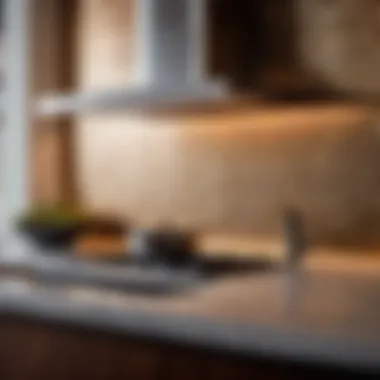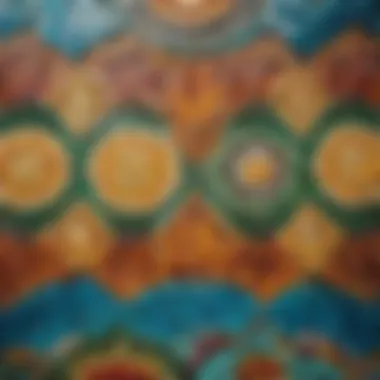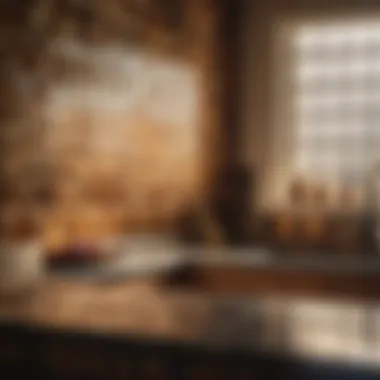Materials:
-
Tiles: Measure the square footage of the backsplash area to determine the quantity needed. Opt for ceramic, glass, porcelain, or natural stone tiles based on your design preference.
-
Grout: Select a suitable grout color and calculate the amount required based on the tile size and spacing.
-
Adhesive: Purchase a high-quality adhesive recommended for the type of tiles you choose.
-
Tools: Gather tools such as a tile cutter, trowel, grout float, sponge, level, tape measure, and buckets.
DIY Steps:
-
Prepare the Wall: Clean and ensure a smooth surface for better adhesion.
-
Tile Layout: Plan the layout to avoid awkward cuts and ensure visual appeal.
-
Applying Adhesive: Spread adhesive on the wall using the trowel, working in small sections.
-
Installing Tiles: Press each tile firmly into place, adding spacers for a consistent gap.
-
Grouting: Once the adhesive sets, fill the gaps with grout using a float at a 45-degree angle.
-
Cleaning: Wipe off excess grout with a damp sponge before it dries completely.
Technical Aspects:
- Tools: Ensure tools are clean and in good condition for efficient work.
- Timing: Follow manufacturer instructions for adhesive and grout drying times.
- Techniques: Use a level to keep tiles straight and apply even pressure during installation.
DIY Project Process:


-
Sequential Steps: Work methodically from one end to the other, adjusting as needed for corners or outlets.
-
Troubleshooting Tips: To fix uneven spacing, carefully reposition tiles, and use a level for accuracy.
-
Final Touches: Seal the grout once it cures to prevent stains and enhance durability.
-
Maintenance: Regularly clean the backsplash with a mild cleanser to preserve its appearance.
Factors Impacting the Cost of Backsplash Installation


In this comprehensive guide on the cost of installing a backsplash, we delve into the various factors that play a crucial role in determining the overall expenses associated with this home improvement project. From the materials chosen to the complexity of the design, labor requirements, and the size of the area to be covered, each aspect contributes significantly to the final cost. By understanding and considering these key factors, homeowners can effectively budget for their backsplash installation project, ensuring a satisfactory outcome that aligns with their financial means and aesthetic preferences.
Materials Cost
When it comes to the materials selected for a backsplash, the cost can vary significantly based on the type chosen. Tiles are a popular choice due to their versatility, durability, and wide range of options in terms of colors, patterns, and sizes. Glass backsplashes add a modern and sleek touch to any kitchen, although they can be more expensive than traditional options. Stone backsplashes provide a luxurious and natural look but may require higher maintenance. Metal backsplashes offer a contemporary aesthetic and are highly durable. Grout and adhesive are essential components that tie the materials together but also come with their own set of considerations in terms of quality and cost.
Tile
Tiles are a versatile and durable choice for backsplashes, offering a wide array of design possibilities to suit various styles and preferences. Their affordability and ease of maintenance make them a popular option for homeowners looking to achieve a stylish yet practical backsplash.
Glass
Glass backsplashes are renowned for their sleek and modern appearance, adding a sophisticated touch to any kitchen or bathroom. While they can be more expensive than other materials, their reflective properties can enhance light and create a sense of spaciousness in the room.
Stone
Stone backsplashes, such as marble or granite, bring a touch of elegance and luxury to any space. However, they require regular sealing to prevent stains and damage, adding to their overall cost and maintenance requirements.
Metal
Metal backsplashes, like stainless steel or copper, offer a contemporary look and exceptional durability. While they can be more of an investment upfront, their longevity and easy cleaning make them a popular choice for modern kitchens.
Grout and Adhesive
Grout and adhesive are the unsung heroes of backsplash installation, providing stability and cohesion to the chosen materials. However, the quality of grout and adhesive can impact the overall durability and visual appeal of the backsplash, making it essential to select high-quality options that align with the chosen materials.
Labor Cost
The labor cost of a backsplash installation can vary depending on whether homeowners opt for professional installers or choose to tackle the project themselves. Hiring a professional installer ensures precision and expertise in the installation process, albeit at a higher cost. On the other hand, DIY installation can lead to cost savings but requires time, skill, and attention to detail to achieve professional results.
Hiring a Professional Installer
Enlisting the services of a professional installer guarantees a smooth and efficient installation process, minimizing errors and ensuring a flawless end result. While this option may come at a higher cost, the expertise and skill of professional installers can contribute to a durable and visually appealing backsplash.
DIY Installation
DIY installation offers homeowners the opportunity to take a hands-on approach to their backsplash project, potentially saving on labor costs. However, DIY projects require careful planning, preparation, and execution to avoid mistakes and achieve a high-quality finish. Homeowners should assess their skill level and the complexity of the design before embarking on a DIY installation to ensure a successful outcome.
Design Complexity
The design complexity of a backsplash can significantly impact the overall cost of the installation. Intricate patterns and custom cuts require more time and effort to achieve, leading to higher labor costs and potential material wastage. Homeowners should carefully consider the level of design intricacy they desire and the associated costs to align their preferences with their budget constraints.
Intricate Patterns
Intricate patterns in a backsplash design add a decorative element and visual interest to the space, showcasing personalized style and creativity. However, these intricate patterns may require meticulous attention to detail during installation, increasing labor costs and the overall time required to complete the project.
Custom Cuts
Custom cuts in backsplash materials allow for unique and tailored designs that suit specific spatial requirements. While custom cuts offer a bespoke appearance, they can also result in higher material wastage and increased labor expenses. Homeowners should weigh the benefits of custom cuts against the additional costs involved to make an informed decision that meets their design vision and budget.
Size of the Area
The size of the area to be covered by the backsplash is a fundamental consideration when estimating the total cost of installation. Both the square footage of the backsplash area and the height of the backsplash impact the amount of materials needed and the labor required, influencing the overall expenses incurred during the project.
Square Footage
The square footage of the backsplash area directly correlates with the amount of material required for installation. Larger backsplash areas necessitate more tiles or other materials, increasing the overall cost of both materials and labor. Homeowners should carefully measure the square footage of their backsplash area to accurately estimate material quantities and associated costs.
Height of Backsplash
The height of the backsplash plays a crucial role in the visual impact and functionality of the installation. Taller backsplashes provide greater protection for walls against moisture and stains but may require more time and materials to install. Homeowners should consider the height of their backsplash in relation to their design preferences and practical needs when planning and budgeting for the project.
Calculating the Total Cost


Calculating the total cost is a crucial step in the backsplash installation process as it gives a clear picture of the financial outlay required for the project. By breaking down the various expenses involved, homeowners can effectively plan their budget and avoid unforeseen costs.
Factors such as materials cost, labor charges, design complexity, and the size of the area all contribute to determining the total cost. Each of these elements plays a significant role in shaping the overall budget for the installation project.
Materials cost is a key component when calculating the total expenses. Different materials like tiles, glass, stone, metal, grout, and adhesive come with varying price points that influence the overall cost. Labor cost, whether hiring a professional installer or opting for a DIY approach, also impacts the total expenditure.
Design complexity adds another layer of cost consideration, especially when opting for intricate patterns or custom cuts. The more intricate the design, the higher the cost implication. Additionally, the size of the area to be covered, including square footage and the height of the backsplash, directly affects the total cost.
Careful calculation of these elements is essential to avoid budget overruns and ensure a smooth installation process. Homeowners should meticulously assess each factor to arrive at an accurate estimation of the total cost before proceeding with the project.
Cost per Square Foot
When it comes to backsplash installation, the cost per square foot is a vital metric that influences the overall budget. This measure helps homeowners understand the pricing structure based on the size of the area to be covered with the backsplash.
Calculating the cost per square foot involves dividing the total expenses by the square footage of the backsplash area. It provides a clear indication of how much investment is required for each unit area, allowing for better budgeting and cost management.
Factors such as material selection, labor charges, design complexity, and additional expenses impact the cost per square foot. Choosing high-end materials or intricate designs typically result in a higher cost per square foot compared to more budget-friendly options.
By analyzing the cost per square foot, homeowners can make informed decisions, optimize their budget, and ensure a cost-effective backsplash installation. This metric serves as a valuable tool in the planning and execution of the project, helping individuals achieve the desired aesthetic while staying within budget constraints.
Additional Expenses to Consider
When embarking on a backsplash installation project, it's pivotal to factor in various additional expenses to ensure a smooth and successful process. These extra costs play a crucial role in the overall budgeting and outcome of the project, making them essential considerations for a comprehensive understanding of the financial aspects involved. By being mindful of these additional expenses, homeowners can avoid last-minute surprises and better prepare for the total investment required for their desired backsplash.
Demolition of Existing Backsplash
The demolition of an existing backsplash is a fundamental step in preparing for a new installation. Whether the current backsplash is outdated, damaged, or no longer suits the aesthetic vision of the space, its removal is necessary to create a clean slate for the upcoming project. Demolition costs may vary depending on the materials of the existing backsplash, the labor required, and any potential repairs needed behind the backsplash surface. Ensuring thorough demolition is essential for the success and longevity of the new backsplash.
Repairs and Preparations
Before installing a new backsplash, it's crucial to address any underlying repairs and preparations needed to guarantee a stable and lasting result. Repairing damaged drywall, fixing uneven surfaces, or resolving structural issues are all part of the preparatory work that may incur additional expenses but are indispensable for a flawless installation. By investing in these repairs and preparations, homeowners can safeguard their investment and prevent future issues that could arise due to overlooked faults.
Sealing and Finishing
Sealing and finishing the backsplash is the final touch that enhances its durability and aesthetics. Sealants protect the backsplash from moisture, stains, and damage, extending its lifespan and maintaining its charm over time. Choosing the right sealer and finish for the specific material of the backsplash is essential to ensure proper protection and a polished appearance. While the cost of sealing and finishing may add to the overall expenses, it is a worthwhile investment to maintain the integrity and beauty of the backsplash for years to come.
Unexpected Costs
Despite meticulous planning, unexpected costs can arise during a backsplash installation project, impacting the final budget. Structural issues such as hidden plumbing problems or electrical concerns can lead to unforeseen expenses that need immediate attention to ensure the safety and functionality of the space. Additionally, design changes requested midway through the project may incur extra costs due to alterations in materials or labor. By anticipating and budgeting for unexpected expenses, homeowners can navigate challenges seamlessly and achieve their desired backsplash outcome.
Cost-Saving Tips and Strategies
In the realm of backsplash installation, understanding cost-saving tips and strategies can be a game-changer, allowing homeowners to achieve their desired look without breaking the bank. By delving into the specifics of this topic, individuals can navigate their project more effectively and make informed decisions that align with their budget constraints.
One crucial element to consider is the choice between DIY installation and hiring a professional. While opting for a DIY approach may seem cost-effective initially, it's essential to assess one's skills and the complexity of the project. DIY enthusiasts should be prepared for challenges and potential setbacks, which could end up costing more in the long run if mistakes are made. On the other hand, professional installers bring expertise and efficiency to the table, ensuring a seamless and high-quality result. It's a balance between cost and quality that homeowners need to weigh carefully.
When it comes to selecting materials, choosing affordable options can significantly impact the overall cost of the project. Affordable does not have to mean compromising on quality; there are budget-friendly materials that can mimic the look of higher-end options at a fraction of the price. Homeowners should explore various materials, comparing their cost, durability, and aesthetic appeal to find the best fit for their budget and style preferences.
Comparing quotes from different contractors is another valuable strategy to save on costs. By obtaining multiple quotes, homeowners can gauge the average cost of the project and identify any outliers. This process allows for negotiation and potentially securing a better deal. However, it's essential to look beyond the price and consider the contractor's reputation, experience, and portfolio to ensure a successful and satisfactory installation.
In essence, incorporating cost-saving tips and strategies into the backsplash installation project can lead to significant savings without compromising on quality or design. By being strategic and meticulous in decision-making, homeowners can achieve a stunning backsplash that enhances their space while staying within budget constraints.





